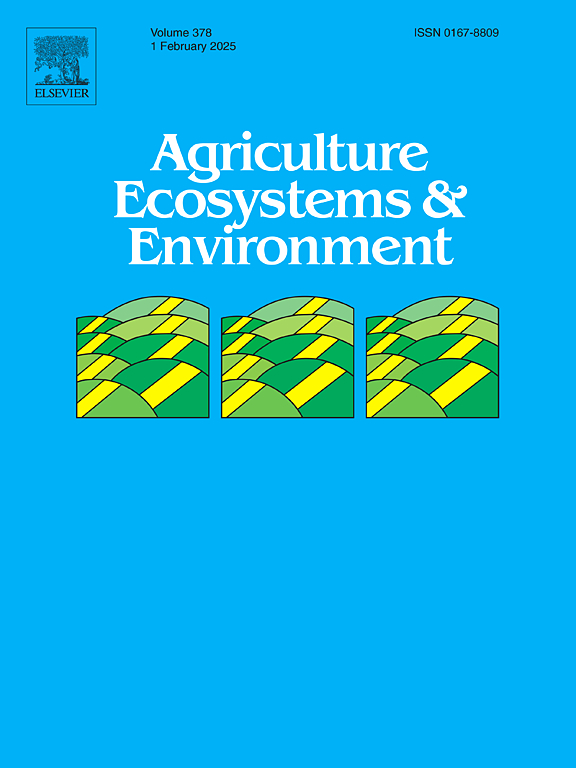Water-saving irrigation practices in rice paddies reverse the impact of root aerenchyma on methane emissions
IF 6
1区 农林科学
Q1 AGRICULTURE, MULTIDISCIPLINARY
引用次数: 0
Abstract
Rice root aerenchyma (RA) and irrigation practices influence key physiological processes in rice paddies, affecting both yield and methane (CH4) emissions. However, the interaction between RA and irrigation practices, and its implications for CH4 mitigation, remains unclear, making it difficult to identify rice cultivars for CH4 mitigation purposes. Here, we conducted a series of field and pot experiments to evaluate how RA affects grain yield and CH4 emissions under two common irrigation regimes: continuous flooding (CF) and alternate wetting and drying (AWD). Our results show that the interaction between RA and irrigation regime significantly influenced both rice yield and CH4 emissions. Under CF, increased RA formation was associated with higher rice yield and lower CH4 emissions across a wide range of cultivars. These results could be explained by cultivars with well-developed RA increasing root oxygen loss, thereby stimulating CH4 oxidation and promoting N availability to support plant growth. In AWD systems, no significant differences in rice yield, methanogenesis or methanotrophy were observed between cultivars with varying RA development. However, cultivars with well-developed RA increased CH4 emissions by 28 %−32 % compared to those with less-developed RA, likely due to enhanced CH4 transport from anaerobic deep soil layers to the atmosphere. Consistent with these findings, CH4 emissions under AWD decreased when we inhibited RA development through root irrigation with brassinosteroids. In conclusion, we demonstrate that AWD in paddies can reverse the impact of RA on CH4 emissions, highlighting the need for CH4 mitigation strategies involving cultivar selection to account for variations in irrigation practices.
水稻田节水灌溉措施可逆转根瘤对甲烷排放的影响
水稻根部气孔(RA)和灌溉方法会影响稻田的关键生理过程,从而影响产量和甲烷(CH4)排放。然而,RA 与灌溉方式之间的相互作用及其对甲烷减排的影响仍不清楚,因此很难确定用于甲烷减排的水稻品种。在此,我们进行了一系列田间和盆栽实验,以评估在两种常见灌溉制度(连续淹水(CF)和干湿交替(AWD))下 RA 如何影响谷物产量和 CH4 排放。结果表明,RA 与灌溉制度之间的相互作用对水稻产量和甲烷排放量都有显著影响。在 CF 条件下,RA 形成的增加与水稻产量的提高和各种栽培品种的 CH4 排放量的降低有关。这些结果可能是由于RA发达的栽培品种增加了根部的氧气损失,从而刺激了CH4氧化,促进了氮的供应以支持植物生长。在 AWD 系统中,RA 不同的栽培品种在水稻产量、甲烷生成或甲烷营养方面没有明显差异。然而,与RA发育程度较低的品种相比,RA发育良好的品种CH4排放量增加了28%-32%,这可能是由于CH4从厌氧深层土壤向大气传输的能力增强所致。与这些发现一致的是,当我们通过使用黄铜类固醇灌根来抑制 RA 的发育时,AWD 条件下的 CH4 排放量会减少。总之,我们证明了水稻全灌溉可以逆转RA对CH4排放的影响,这突出表明需要制定CH4减缓策略,包括选择栽培品种,以考虑灌溉方法的变化。
本文章由计算机程序翻译,如有差异,请以英文原文为准。
求助全文
约1分钟内获得全文
求助全文
来源期刊

Agriculture, Ecosystems & Environment
环境科学-环境科学
CiteScore
11.70
自引率
9.10%
发文量
392
审稿时长
26 days
期刊介绍:
Agriculture, Ecosystems and Environment publishes scientific articles dealing with the interface between agroecosystems and the natural environment, specifically how agriculture influences the environment and how changes in that environment impact agroecosystems. Preference is given to papers from experimental and observational research at the field, system or landscape level, from studies that enhance our understanding of processes using data-based biophysical modelling, and papers that bridge scientific disciplines and integrate knowledge. All papers should be placed in an international or wide comparative context.
 求助内容:
求助内容: 应助结果提醒方式:
应助结果提醒方式:


